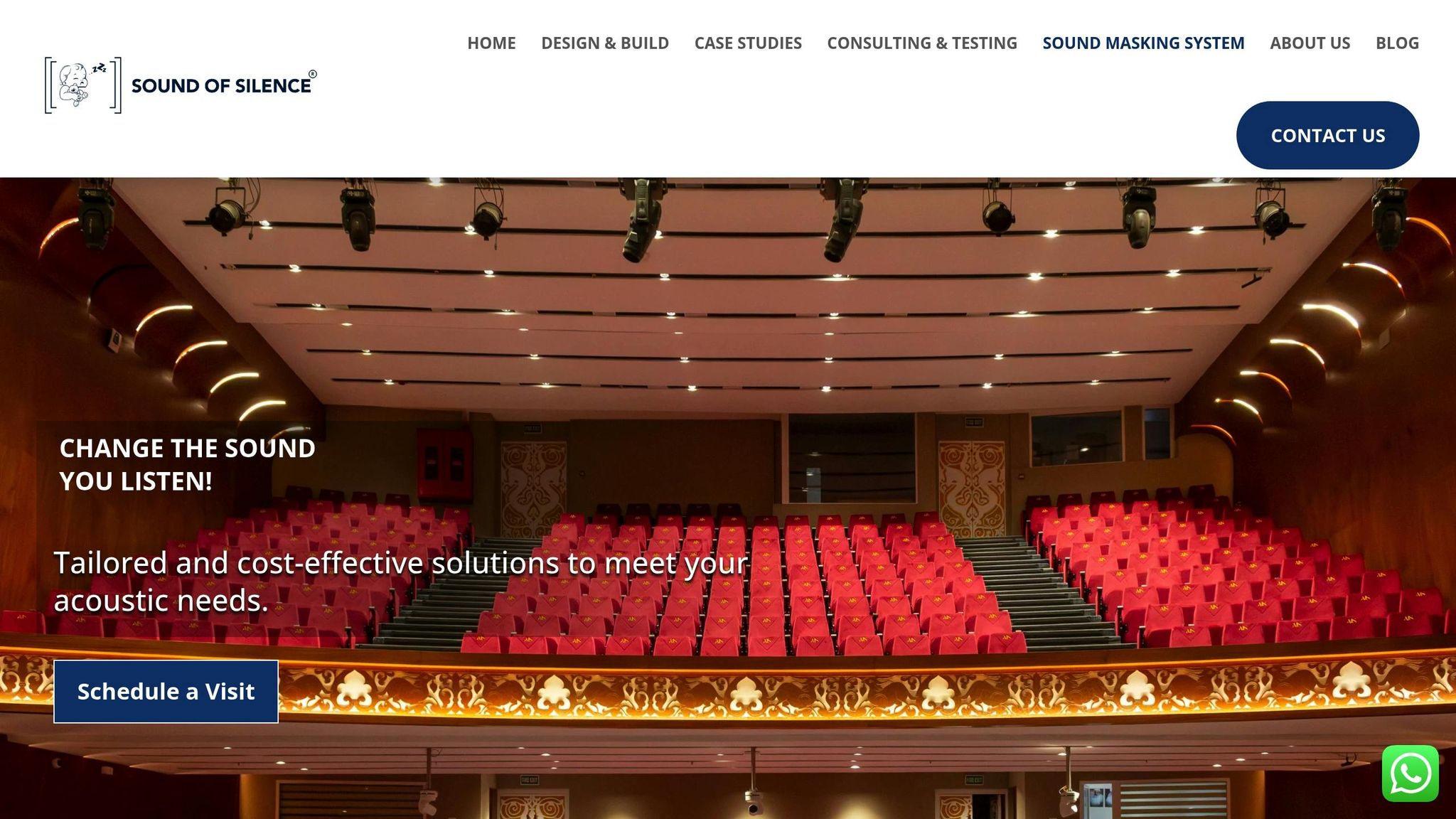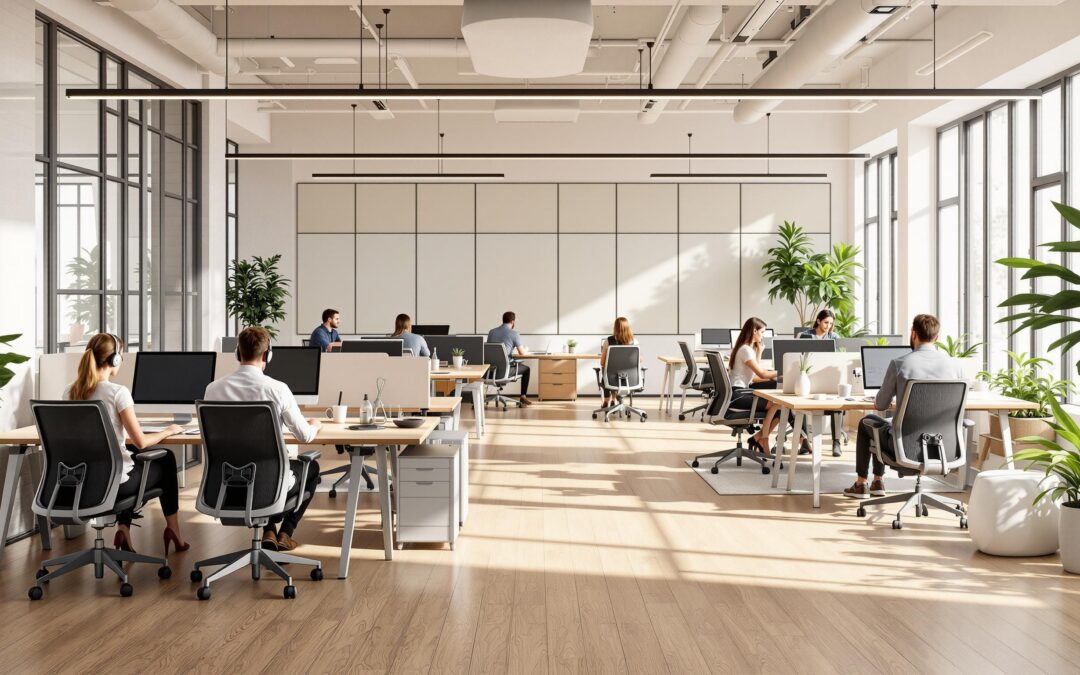Noise is the biggest challenge in open-plan offices. It disrupts focus, increases stress, and affects productivity. Here’s how to fix it:
- Main Problems: Human chatter, office equipment noise, and external sounds like traffic.
- Impact: Reduced concentration, higher stress, and less privacy for conversations.
- Solutions:
- Use sound-absorbing materials (panels, ceiling tiles, dividers).
- Install white noise systems to mask distractions.
- Design smart office layouts with separate zones for quiet work and collaboration.
- Set clear noise policies like designated quiet areas and meeting room bookings.
Professional acoustic solutions, like those offered by specialists, can customise noise control to your office’s needs, ensuring a productive and comfortable workspace.
Start improving your office acoustics today for better focus and happier employees.
How to: Soundproofing and Noise Control in Offices and …
Noise Problems in Open Offices
Open offices come with unique noise challenges that can disrupt productivity. Identifying the main sources of noise and understanding their impact on employees is key to creating better acoustic environments.
Main Noise Sources
Noise in open offices generally comes from three main areas:
- Human-Generated Noise: Conversations, phone calls, and general movement contribute significantly. When multiple people are talking or moving around at the same time, the noise levels rise, making it harder for others to focus.
- Equipment Noise: Office devices like printers, copiers, air conditioning units, and computer accessories add to the background noise. While each device may not seem loud on its own, their combined sounds can become distracting and make communication difficult.
- External Noise: Sounds from outside, such as traffic, construction work, or maintenance in nearby buildings, can seep into the office and make the environment even noisier.
Effects on Work Performance
Noise in the workplace affects employees in several ways:
- Physical Effects: Long-term exposure to noise can increase stress levels and cause fatigue, making it harder to stay energised throughout the day.
- Cognitive Impact: Noise disrupts concentration, making tasks like decision-making and processing information much more difficult.
- Behavioural Changes: A noisy environment can lead to irritability and reduced teamwork. It can also lower overall job satisfaction and harm workplace relationships.
Addressing these issues requires specific noise management strategies, which will be discussed in the following section.
Noise Control Methods
Reducing noise in open offices requires a mix of physical adjustments, technology, and workplace guidelines. These strategies work together to minimise distractions and create a more focused environment.
Sound Absorption Techniques
Incorporating sound-absorbing materials can help reduce echoes and reverberation:
- Wall Panels: Install panels on walls or suspend them to cut down on sound reflections.
- Ceiling Tiles and Baffles: Use these to manage overhead noise effectively.
- Dividers: Add partitions to block sound travelling directly between workstations.
White Noise Systems
Sound masking systems produce a steady background noise that helps cover up distracting sounds. This can improve privacy and make the office environment less disruptive.
Office Design and Policies
Creating a quieter workspace involves thoughtful planning and clear rules:
- Smart Layouts: Separate noisy equipment and high-traffic zones from areas meant for focused work.
- Furniture Placement: Arrange desks and meeting spaces to act as natural sound barriers.
- Guidelines for Noise:
- Set up designated quiet zones.
- Use booking systems for meeting rooms to avoid overcrowding.
- Clearly define acceptable noise levels for different office areas.
sbb-itb-06ab728
Sound-Smart Office Design
Create a workspace with balanced acoustics by combining thoughtful layouts and smart material choices.
Activity-Based Areas
Effective noise management starts with zoning the office for different activities. Assign specific areas for focused tasks and group discussions to minimise distractions and improve comfort.
Quiet zones – set away from busy pathways and featuring reading nooks or phone booths – help boost concentration. For team collaboration, use meeting pods or brainstorming areas equipped with sound-dampening features to support productive discussions.
Adding clear signage with noise level expectations and behaviour guidelines reinforces the purpose of each area. These zones provide the foundation for incorporating materials that enhance the office’s acoustics.
Sound-Absorbing Materials
Choose materials that reduce sound reflections in noisy sections. Acoustic treatments not only improve privacy but also help control overall noise levels. Consulting professionals can help you find cost-effective, customised solutions.
Using a mix of acoustic elements throughout the office creates a balanced approach. This method ensures noise control while maintaining a visually appealing design, meeting both practical and aesthetic goals.
Professional Acoustic Solutions
Professional acoustic solutions take noise control and design to the next level, improving the overall sound quality in open office spaces. These expert methods tackle complex noise issues, making shared work environments more comfortable and efficient.
Why Custom Solutions Work
Custom acoustic treatments address specific noise problems in an office, offering precise and cost-efficient results. A professional assessment typically considers:
- Room layout and traffic flow: How people move and interact in the space.
- Surface acoustic properties: How walls, floors, and ceilings affect sound.
- Primary noise sources: Identifying the main contributors to unwanted noise.
- Daily usage patterns: How the space is used throughout the day.
By focusing on these factors, custom solutions provide better results than one-size-fits-all methods. They align with smart office design, creating spaces suitable for a variety of work activities.
Sound of Silence Services

Sound of Silence specialises in creating tailored acoustic solutions for open offices. Their services cover everything from consulting to ongoing maintenance, ensuring effective noise management. Here’s what they offer:
- Acoustic consulting and testing: Identifying and analysing noise issues.
- Sound masking systems: Reducing distractions and improving speech privacy.
- Custom soundproofing: Designing solutions for specific noise problems.
- Ongoing monitoring: Ensuring the acoustic environment stays effective over time.
The process starts with acoustic testing to identify baseline issues. Sound masking systems are then introduced to minimise distractions while ensuring conversations remain private. These systems work alongside other treatments to create a well-balanced sound environment.
For long-term success, an integrated strategy is key. This includes:
- Professional consultation to identify problems and solutions.
- Customised treatments tailored to the space.
- Strategic use of sound masking systems.
- Regular monitoring to adapt to changing needs.
This comprehensive approach ensures a workspace that supports both collaboration and focused tasks, complementing earlier noise control methods and design principles.
Summary
Managing noise in open offices requires a mix of smart design, advanced tools, and expert knowledge. A carefully designed acoustic setup can boost productivity and improve employee wellbeing by addressing specific noise issues effectively.
Using techniques like sound masking, sound absorption, and thoughtful office layouts creates spaces that balance collaboration with quiet areas for focused work. The key is maintaining a balance between noise control and the natural flow of office activities.
Here are some practical noise management strategies:
- Conduct professional acoustic testing to assess current noise levels.
- Develop tailored solutions that fit the office’s layout and usage patterns.
- Use a mix of control methods for a more effective approach.
- Regularly monitor and adjust as office needs and dynamics change.
Sound of Silence offers a tailored approach to managing acoustics in open offices. Their cost-efficient solutions address unique challenges, ensuring a quieter and more productive workplace.

